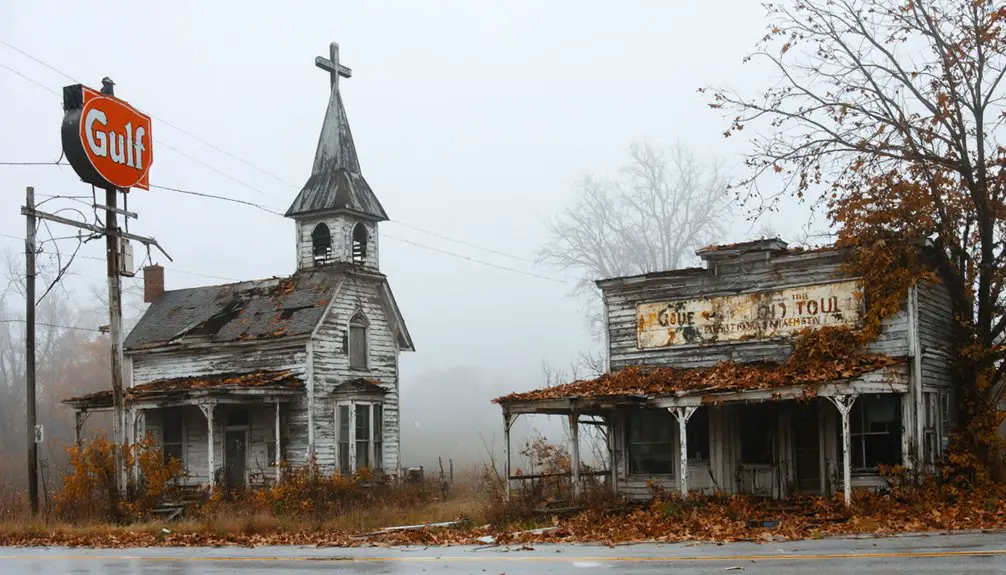You’ll find Robindale, Pennsylvania’s haunting remains along the Robindale Memorial Highway, where this once-thriving coal mining town met its demise through a series of tragic events. After its 1856 establishment by the Cambria Iron Company, the community faced devastating mine accidents in 1916, persistent underground fires starting in 1962, and catastrophic floods. By the 1990s, government intervention through eminent domain forced the last residents to abandon their homes. The town’s silent streets hold countless untold stories of Pennsylvania’s coal country.
Key Takeaways
- Robindale emerged as a coal mining town in the mid-19th century following coal deposits discovered in the late 1700s.
- Two major mining accidents, including an explosion in 1916 that killed eight miners, contributed to the town’s decline.
- Underground coal fires, toxic emissions, and environmental damage from abandoned mines made the area increasingly uninhabitable.
- The Pennsylvania government used eminent domain in 1993 to force remaining residents out due to hazardous conditions.
- Population decline accelerated as mining families moved away, leading to shuttered businesses and eventual abandonment of the town.
The Rise of a Coal Mining Community
While coal deposits near Robindale were first discovered in the late 1700s, the area’s transformation into a thriving mining community didn’t begin until the mid-19th century.
You’ll find the catalyst for this growth came in 1856 when Cambria Iron Company launched operations nearby, sparking increased coal demand throughout the region.
The community development accelerated as coal mining companies established company towns like Woodvale and Robertsdale to house their growing workforce. They recruited immigrants from Southern and Eastern Europe, who brought their rich cultural traditions to the area. By 1885, the region was producing an impressive over a million tons of coal annually.
Immigrants from Europe shaped these company towns, weaving their homeland customs into the fabric of Pennsylvania’s growing mining communities.
The strategic location near railroads, highways, and ocean transport made coal distribution efficient, while shortline railroads like the Cambria & Indiana supported the expanding mining operations. The area became renowned for its high quality coal deposits, attracting major industrial buyers.
Local firms and industry giants like Bethlehem Steel controlled multiple mines, cementing Robindale’s position in Pennsylvania’s coal country.
Mining Disasters and Their Impact
If you’d explored Robindale’s coal mines in 1916, you’d have witnessed the devastating March 30th explosion that killed eight miners and marked the first of two major mining disasters in the town’s history.
These catastrophic events, combined with Pennsylvania’s broader pattern of mining fatalities that claimed thousands of lives yearly in the early 1900s, fundamentally altered Robindale’s trajectory. In 1916 alone, falling rock and coal caused 961 underground deaths across U.S. mines.
The lack of proper safety equipment in early mining operations contributed significantly to the high death toll in incidents like these. The town’s mining legacy endures through persistent underground fires, abandoned tunnels, and commemorative efforts like the Robindale Memorial Highway, which honors those who lost their lives beneath the earth.
Loss of Mining Lives
Throughout Pennsylvania’s mining history, the staggering toll of human lives lost in coal mines cast a dark shadow over the industry, with the state accounting for roughly 61% of all U.S. coal mining fatalities from 1860 through World War I.
You’ll find that mining fatalities struck communities hard, with over 13,000 Pennsylvania miners dying in just the first decade of the 1900s. The deadliest disasters shook towns like Johnstown, where 112 perished in 1902, Cheswick, claiming 179 lives in 1904, and Marianna, losing 154 souls in 1908. Young boys as young as eight worked alongside men in these treacherous conditions, putting their lives at risk daily.
These catastrophic losses spurred demands for safety reforms, as miners faced daily threats from explosions, fires, roof collapses, and floods. The Pennsylvania State Archives maintain detailed registers documenting coal mine accidents from 1899 to 1972, preserving the tragic history of these workplace disasters. Each disaster left behind devastated families, with widows and children depending on mine relief funds for survival.
Underground Fire Legacy
Three major underground mine fires in Pennsylvania’s anthracite region left an indelible mark on Robindale and surrounding coal communities during the early-to-mid 20th century.
You’ll find that these fires, including the devastating Laurel Run Mine Fire of 1915, persisted for decades despite intensive fire containment efforts.
When the Knox Mine disaster struck in 1959, flooding from the Susquehanna River complicated existing fire situations by restricting ventilation and access for firefighting crews.
The impact on Robindale’s community resilience was severe – toxic gases forced families to relocate, while miners lost their livelihoods as large companies abandoned their mining operations.
Traditional firefighting methods proved useless underground, requiring specialized techniques like inert gas injection and concrete sealing.
Yet some fires continue burning today, a reflection of the challenge of extinguishing subterranean coal seam blazes.
Environmental Challenges and the Underground Fire
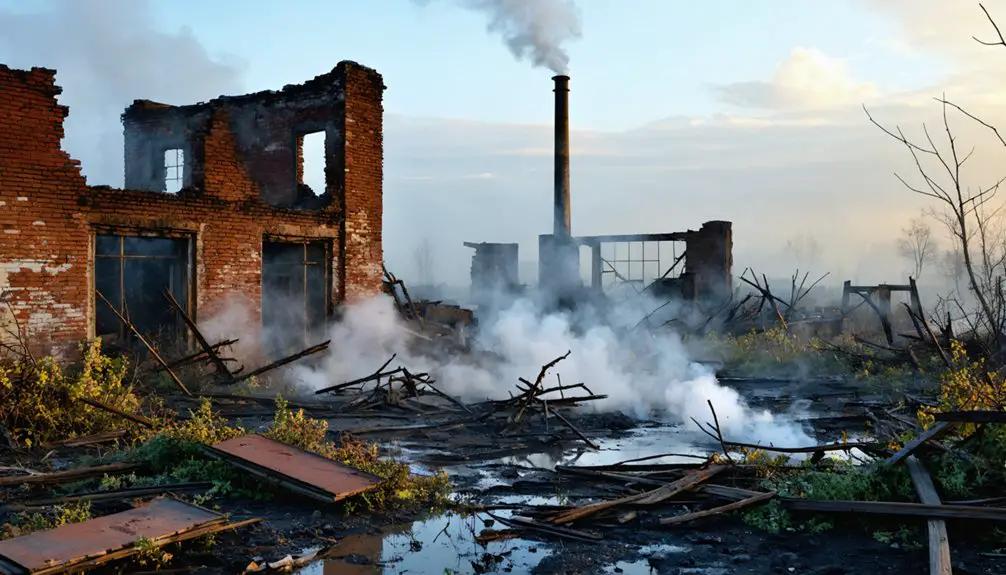
If you’d visited Robindale in the early 1960s, you’d have encountered toxic carbon monoxide seeping through mine wall cracks, with state inspectors recording lethal gas levels by August 9, 1962.
You’d have witnessed how the underground coal fire, which began in May 1962 from a residential trash burn, spread rapidly through abandoned Buck Mountain Coal Bed workings, creating unstable ground conditions and dangerous subsidence.
The initial $30,000 containment estimate in 1962 proved woefully inadequate as the fire continued its relentless advance, fueled by seemingly limitless coal seams that would keep burning for at least another century.
Ground temperatures soared to dangerous levels, reaching over 900 degrees Fahrenheit.
The fire’s devastation stretched across eight miles underground, transforming the once-thriving community into an uninhabitable wasteland.
Toxic Fumes and Hazards
While Robindale’s underground coal fires posed significant dangers, the toxic emissions from coal refuse piles created an even more insidious environmental threat.
You’d find these abandoned piles throughout Western Pennsylvania, spontaneously combusting and releasing hazardous fumes into the air. The acid mine drainage from these refuse sites also contaminated local waterways, creating additional environmental concerns. The health risks couldn’t be ignored – residents reported eye irritation, respiratory problems, and an unsettling “zombie-like” fatigue from exposure to carbon monoxide and other poisonous gases.
If you ventured near these areas, you’d encounter warning signs marking unstable ground and dangerous gas levels.
Steam vents would appear through cracks in abandoned roads, signaling the ongoing combustion below. The toxic gases could accumulate in enclosed spaces, making monitoring essential for survival in this compromised landscape.
Underground Fire’s Brutal Impact
Since the 1960s, Robindale’s underground coal fire has released devastating environmental impacts across the region’s ecosystem.
You’ll witness the brutal transformation of once-fertile soil into a hostile environment where native microbes struggle to survive. Despite their microbial resilience, these communities face unprecedented challenges as coal pollutants alter the land’s chemical makeup.
- The fire’s intense heat has created geological hazards, causing ground subsidence that threatens your safety.
- You’ll find fragmented landscapes where ecological succession has stalled, preventing natural recovery.
- The soil’s degradation has made it impossible for you to farm or sustain traditional livelihoods.
- Your community faces continuous exposure to greenhouse gases and toxic emissions that poison the environment.
These conditions have forced residents to abandon their homes, turning Robindale into a stark reminder of coal mining’s destructive legacy.
Cost of Fire Containment
As underground fires continue ravaging Robindale’s coal seams, the astronomical costs of containment projects have deterred meaningful intervention.
You’ll find fire containment costs soaring into the millions, with similar projects like Powderly Mine requiring $5.5 million for a single trench firebreak. Even basic excavation attempts would drain Pennsylvania’s Abandoned Mine Land Program’s resources.
The technical challenges you’d face are staggering – from 150-foot-deep trenches to toxic gas monitoring and specialized safety equipment for workers.
You’re looking at constant environmental testing, surface restoration, and decades of maintenance. With no single entity accepting liability and funding challenges plaguing every proposal, the financial burden remains insurmountable.
Private operators can’t reclaim enough coal to offset costs, while government programs lack sufficient budgets for complete extinguishment.
The Great Floods and Natural Disasters
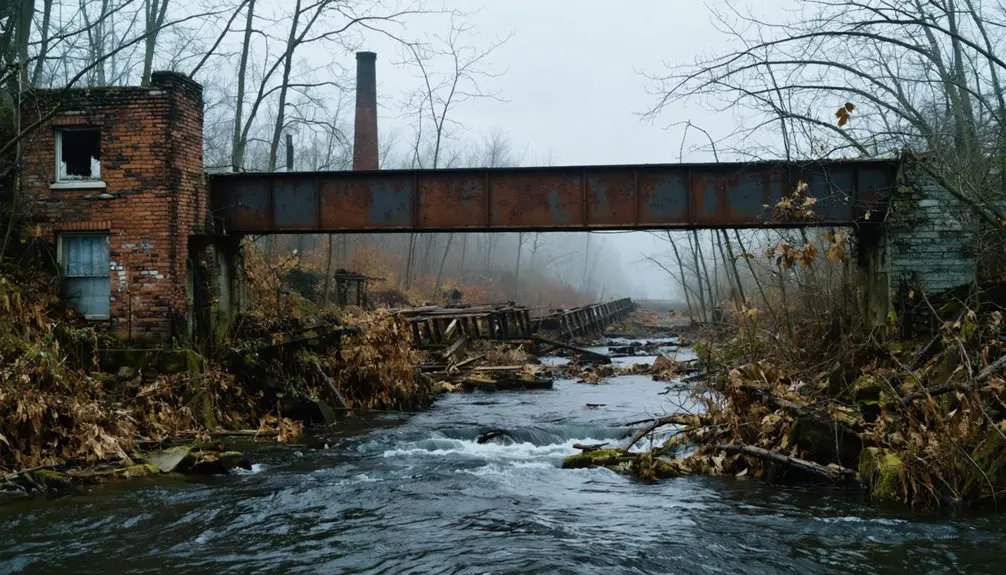
Throughout its history, Robindale and the surrounding Pennsylvania communities endured devastating floods that would ultimately contribute to the town’s decline.
The region’s flood resilience was first tested during the catastrophic 1889 South Fork Dam failure, which released 20 million tons of water on nearby Johnstown. Despite efforts toward disaster preparedness, the area’s geography made it particularly vulnerable to flooding.
The devastating 1889 South Fork Dam collapse unleashed a wall of water that would forever change how Pennsylvania viewed flood safety.
- You’ll find tragic stories of entire families lost in the 1889 flood, with over 2,200 lives claimed and 700 bodies never identified.
- You can trace the destruction path along Black Lick Creek during the 1977 flash flood.
- You’ll hear accounts of the terrifying roar that preceded the rushing waters.
- You’re reminded of nature’s raw power by the multiple floods that repeatedly struck Robindale until its final abandonment.
Economic Decline and Job Loss
The once-prosperous coal mining town of Robindale began its economic downfall in the early 1900s under the Conemaugh Smokeless Coal Company’s operations.
You’d have witnessed the town’s devastating decline through two major mining accidents, followed by the gradual erosion of coal industry jobs and profits.
Despite promises of revival from projects like the 2023 Shell petrochemical plant in nearby Beaver County, you’ll find economic stagnation persisted.
The region’s GDP actually decreased from 2012 levels, while population dropped 2.7%.
Local businesses shuttered as mining families moved away, and environmental damage from abandoned mines limited new development opportunities.
Yet you’ll still see signs of community resilience in efforts to memorialize Robindale’s heritage, even as limited retraining programs and insufficient infrastructure improvements failed to attract new industries.
Population Exodus and Abandonment
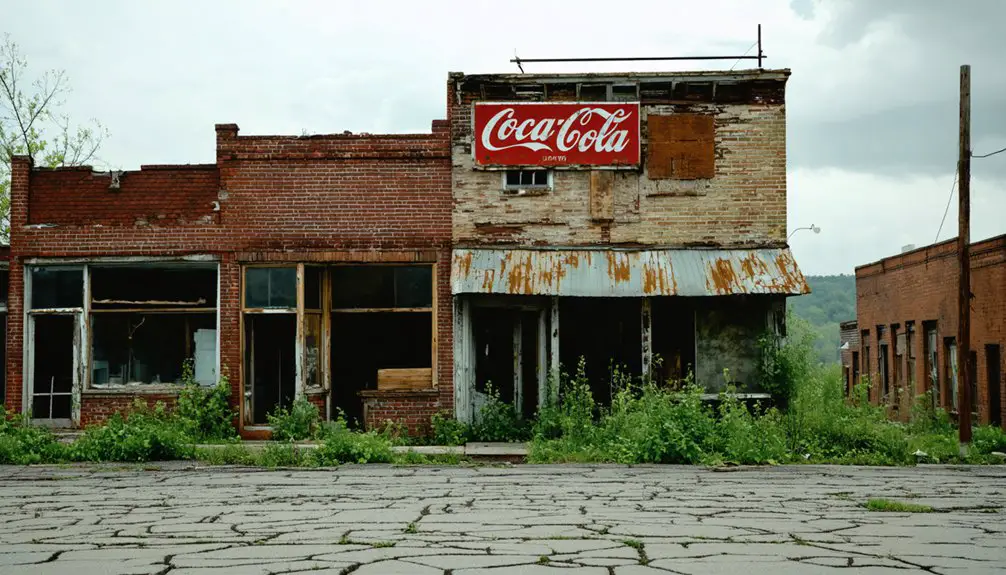
While Robindale’s economic decline set the stage for its abandonment, multiple devastating floods between 1950-1977 ultimately forced residents to flee their homes in Western Pennsylvania’s coal country.
The population decline accelerated as environmental disasters made the area increasingly uninhabitable, shattering the community’s resilience.
You’ll find that Robindale’s community fragmentation unfolded through:
- Voluntary relocations as younger families sought safer ground in nearby towns
- Severe infrastructure damage that made daily life nearly impossible
- Growing fear and uncertainty about future environmental threats
- Final forced evictions in 1993 when the state claimed remaining properties through eminent domain
Government Intervention and Eminent Domain
Following years of failed mitigation efforts, Pennsylvania’s government intervened decisively in Robindale’s mine fire crisis during 1993 by exercising eminent domain over all remaining properties.
You’ll find this government intervention came after officials determined that containing the underground blaze would require a devastating 400-foot-deep trench through town, costing an astronomical $660 million.
The state’s eminent domain action forced out the few remaining residents who hadn’t voluntarily relocated, effectively ending private ownership in the community.
Though some locals had tried to maintain community spirit through events like “Unity Day,” the fiscal and logistical challenges of saving Robindale proved insurmountable.
In 2023, you’ll see the town’s legacy lives on through the newly designated Robindale Memorial Highway.
Cultural Legacy and Historical Significance
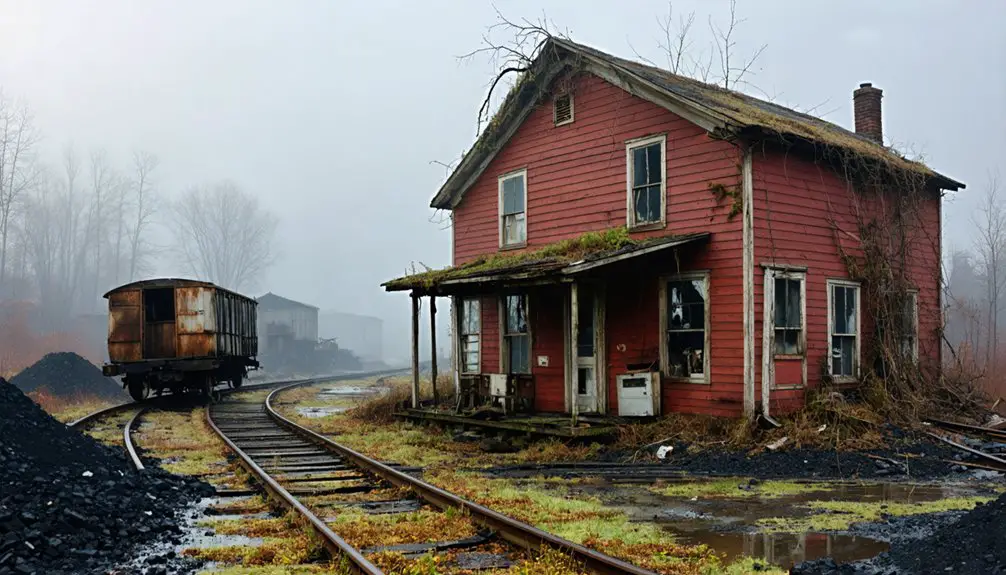
Emerging from the early 1900s as a coal company town, Robindale’s cultural legacy runs deeper than its physical foundations.
Though the 1977 flood erased this Pennsylvania coal town from maps, its spirit of cultural resilience lives on through memorials and community gatherings near the original site.
You’ll find Robindale’s enduring impact through:
- The Robindale Memorial Highway, which stands as a legislative tribute to the town’s mining heritage
- Community reunions that keep family connections alive, showcasing communal pride
- Educational programs that teach future generations about coal mining life
- Historical plaques that preserve stories of triumph and tragedy
Today, former residents and their descendants honor Robindale’s memory through these tangible reminders, ensuring its place in Pennsylvania’s industrial heritage isn’t forgotten.
Present-Day Ghost Town Status
Despite its rich mining heritage, Robindale exists today as a haunting symbol to Pennsylvania’s declining coal industry, with only five permanent residents remaining in the area as of 2025.
These last inhabitants live under special resident agreements that allow them to stay until death, though they face deteriorating infrastructure and limited services.
You’ll find most buildings reduced to ruins, while select structures like The Stone Church remain standing as focal points for ghost town tourism.
Underground mine fires have transformed the landscape into a haunting scene of scorched earth and smoke plumes.
While you can’t freely explore all areas due to safety restrictions and environmental hazards, you’re able to visit designated zones that showcase visible streetscapes and historical remnants under controlled conditions.
Frequently Asked Questions
Are There Any Remaining Structures Still Standing in Robindale Today?
You’ll find a few remaining buildings still standing, including a local church and scattered houses with visible structural reinforcements, though most original architectural features are now deteriorated or partially collapsed.
What Happened to the Displaced Residents After Leaving Robindale?
You’ll find displaced families scattered across Indiana County and nearby towns, where they rebuilt lives while maintaining tight community bonds through reunions, shared memories, and ongoing support networks.
Can Visitors Safely Explore the Ghost Town Despite the Underground Fire?
Want a thrilling way to disappear forever? You shouldn’t explore this area – underground hazards and unstable ground make it extremely dangerous. Stick to viewing historical markers and follow basic safety precautions from designated roads.
Were There Any Attempts to Relocate the Entire Town Elsewhere?
Unlike other mining towns, you won’t find records of formal attempts to relocate Robindale’s entire community. While floods and mining accidents caused disruptions, the town gradually declined without an organized relocation effort.
What Artifacts or Personal Items Were Left Behind by Departing Residents?
Mountains of abandoned possessions tell stories of hasty departures – you’ll find cookware, glass bottles, furniture pieces, children’s toys, and clothing remnants scattered among ruins, each item holding profound historical significance.
References
- https://www.youtube.com/watch?v=8QDb8y9Nszs
- https://uncoveringpa.com/ghost-towns-in-pa
- https://en.wikipedia.org/wiki/List_of_ghost_towns_in_Pennsylvania
- https://www.wikiwand.com/en/articles/List_of_ghost_towns_in_Pennsylvania
- https://www.repstruzzi.com/News/33217/Press-Releases/Struzzi-to-Honor-Memory-of-Robindale-Community
- https://lehighanthracite.com/about/
- https://www.heritagejohnstown.org/attractions/heritage-discovery-center/johnstown-history/history-coal-cambria-county/
- https://www.coalcampusa.com/westpa/broadtop/broadtop.htm
- https://raystown.org/blog/post/coal-mining-a-hard-knock-life/
- https://www.iup.edu/library/departments/archives/coal/coal-culture-timeline.html
